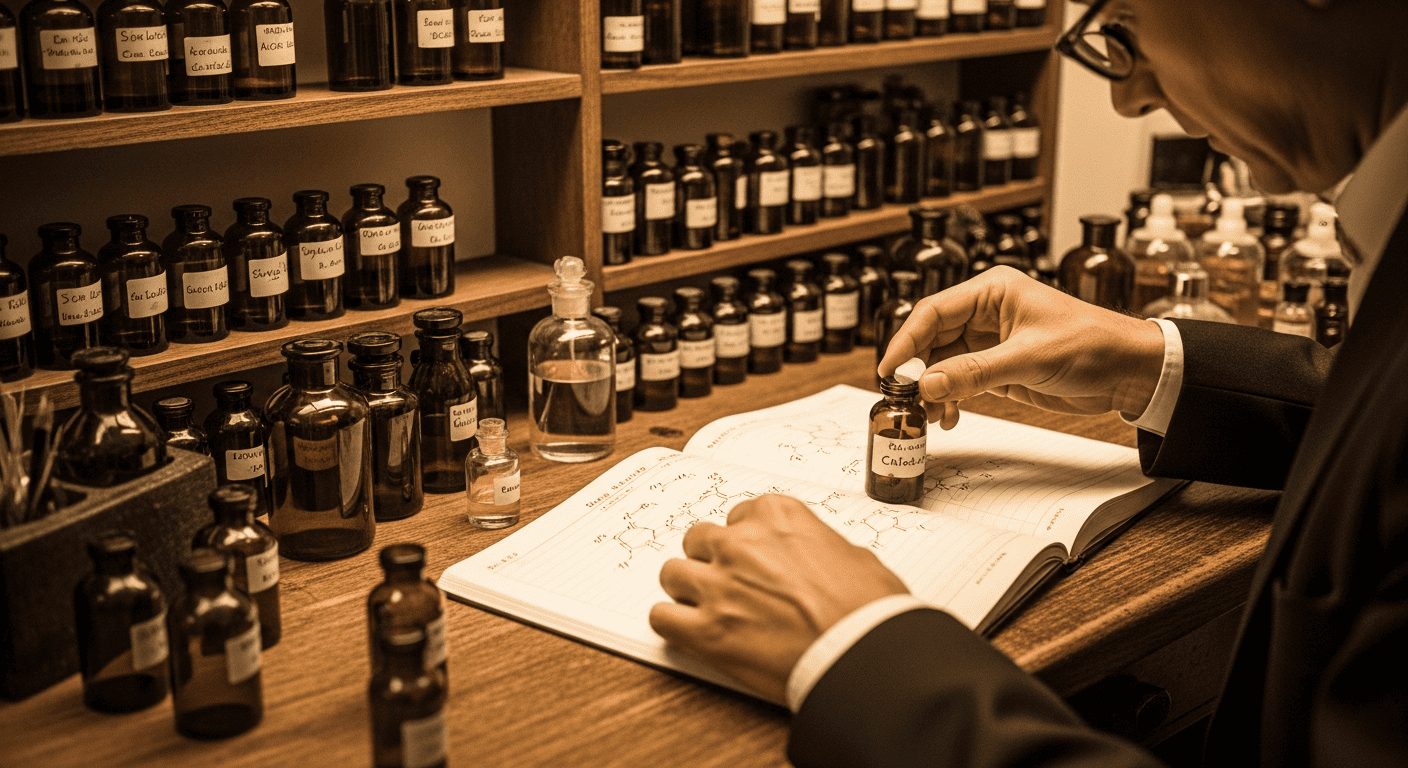The journey to becoming a perfumer has long been shrouded in mystique, a craft passed down through secretive, multi-year apprenticeships. In the mid-20th century, the legendary French perfumer Jean Carles sought to demystify this process, developing a structured, systematic training methodology that remains a cornerstone of perfumery education to this day. The Jean Carles Method is not a shortcut, but a rigorous, logical framework for “learning the alphabet” of scent, designed to build an unshakable foundation in any aspiring nose.
This method transforms the abstract art of fragrance composition into a disciplined science. It forces the student to move beyond subjective preference and learn the true character, strength, and function of each raw material, both individually and in combination with others. It is a foundational education that emphasizes structure and understanding over pure, untutored intuition.
This structured approach to mastering a complex sensory language has parallels in other artistic fields. An artist might study color theory with the same rigor, learning how primary colors combine to create new shades. This educational philosophy is also relevant when exploring how perfumers use scent to manipulate emotion, much like the targeted use of aromas in casino environments to influence behavior, a process that relies on a deep understanding of olfactory cause and effect.
Learning the Olfactory Alphabet
The very first stage of the Jean Carles Method is an exhaustive and repetitive process of memorization. The student is presented with a curated library of the most essential raw materials in perfumery, both natural and synthetic. Their task is to learn each of these “notes” by heart, smelling them blindly on paper blotters day after day until they can identify each one instantly and without hesitation.
This initial phase focuses on building a robust internal scent library. The student learns to differentiate between materials that are olfactively similar, such as different varieties of rose oxide or multiple types of synthetic musk. They create detailed personal notes on each ingredient, describing its character, intensity, longevity, and any unique facets it may possess.
This is the most laborious part of the training, requiring immense patience and dedication. It is the equivalent of a musician learning their scales, a writer mastering vocabulary, or a painter memorizing the properties of their pigments. It is the foundational work upon which all future creative expression will be built.
The Art of the Accord
Once a student has mastered the individual raw materials, the Jean Carles Method progresses to its most crucial stage: the study of accords. An accord is a blend of two or more notes that combine to create a completely new, unified scent impression, where the individual components are no longer easily distinguishable. This is where the true craft of perfumery begins.
The method provides a systematic way to learn these essential building blocks.
- Simple Binary Accords: The student begins by creating simple two-ingredient accords in precise, varying ratios (e.g., 9:1, 8:2, 7:3) to understand how the balance between them changes the final scent.
- Classic Foundational Accords: They then move on to recreating the classic accords that form the basis of many famous perfumes, such as the “Fougère” accord (lavender, oakmoss, coumarin) or the “Chypre” accord (bergamot, labdanum, oakmoss).
- Building Complexity: The student learns how to build upon these simple accords, adding a third or fourth ingredient to modify or enhance the core scent, learning the principles of balance and structure.
- Contrast and Harmony: They are taught to create accords based on both harmony (blending similar notes, like different florals) and contrast (pairing opposing notes, like citrus and woods), understanding the different effects each approach creates.
This structured practice provides the student with a deep, intuitive understanding of how ingredients interact, transforming them from a mere memorizer of notes into a true composer of scents.
From Copyist to Creator
The final stage of the Jean Carles Method involves deconstruction and reconstruction. Students are given a sample of a finished, often famous, perfume and are tasked with recreating it using only their nose and their accumulated knowledge of raw materials and accords. This is the ultimate test of their training, a final exam that synthesizes all the skills they have acquired.
This process, often called “the puzzle,” forces the student to analyze a complex composition, identify its key components and accords, and estimate their relative proportions. They will create dozens of trials, or “mods,” gradually refining their own formula until it closely matches the target fragrance. This is not an act of plagiarism, but a profound learning exercise, akin to an art student copying an Old Master painting to understand the artist’s technique.
By successfully deconstructing and rebuilding a complex work, the apprentice proves they have internalized the principles of fragrance architecture. They have moved beyond simply knowing the alphabet and can now write their own “sentences” and “paragraphs.” It is at this point that they are deemed ready to begin creating their own original compositions.
The Method’s Enduring Legacy
Although Jean Carles developed his method in the 1940s, its principles remain highly relevant and are still taught in some of the world’s most prestigious perfumery schools, most notably the Givaudan Perfumery School, which Carles himself co-founded. The method’s emphasis on a disciplined, bottom-up approach provides a stark contrast to more intuitive or “top-down” styles of creation.
Its enduring legacy lies in its effectiveness at building technically proficient perfumers. An artist trained in the Jean Carles method possesses an unshakeable understanding of their raw materials and the fundamental principles of structure and balance. This technical mastery frees them to be more creative and audacious in their own work, as they are building upon a foundation of solid knowledge.
In an industry that is constantly evolving with new technologies and synthetic molecules, the Jean Carles Method provides a timeless framework for understanding the art of scent. It is a testament to the idea that true creative freedom is born not from chaos, but from a deep and disciplined mastery of the fundamentals.
Frequently Asked Questions
No, it is not. Many successful perfumers are largely self-taught or have learned through more informal, intuitive apprenticeships. However, the Jean Carles Method is considered one of the most structured and rigorous formal training systems and is highly respected for its ability to produce technically skilled and knowledgeable perfumers.
A comprehensive training program based on the Jean Carles Method, such as the one at the Givaudan school, typically takes about three years of full-time, intensive study and practice. The initial memorization phase alone can take many months of daily work.
While the principles can be studied, a true apprenticeship in the method is difficult to replicate on one’s own. The primary challenge is gaining access to the hundreds of specific raw materials, both natural and synthetic, that make up the professional perfumer’s palette. However, dedicated amateurs can apply the core principles by starting with a smaller library of accessible essential oils and aroma chemicals.

